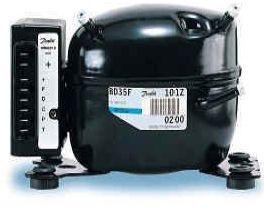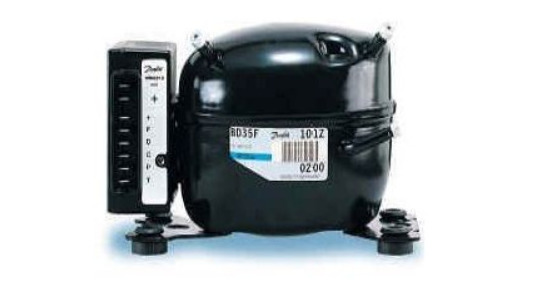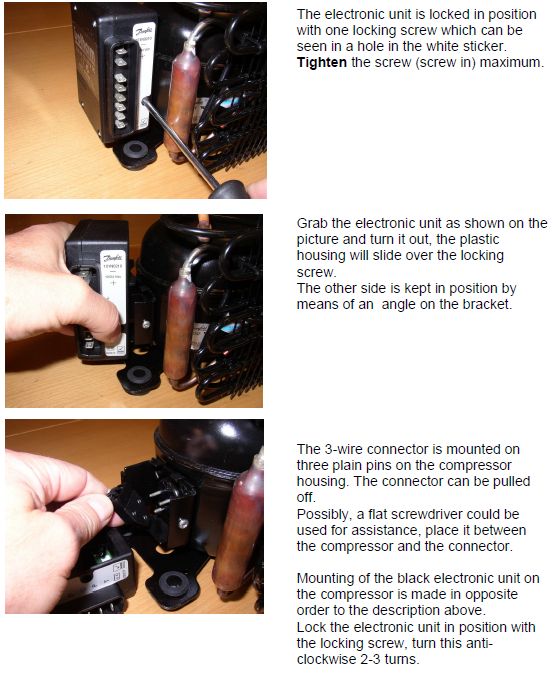Troubleshooting Marine Refrigerators
(excerpts from Indel Webasto USA and Isotherm-parts)
This guide was created to help the non-professional refrigerator owner and professional service company trouble shoot a marine refrigerator. It starts with the most common cause of failure and describes actions you would take to determine the cause of failure.
Loss of Power: A break in the wiring or loose connectors is one of the most common sources of refrigerator failure. To test the power supply for the refrigerator, you must test at the electronics module.
- Start by removing the refrigerator from the cabinet enclosure so you can easily reach the electronics module on the back of the refrigerator.
- The refrigerator is held with screws in the flange to the face of the cabinet. Remove these screws and gently pull the refrigerator from the enclosure. There should be sufficient length of wire to set the refrigerator down in front of the enclosure with power wires still connected.
- With a voltage meter, test the voltage coming in to the power connectors by inserting the probes into the positive and negative power inputs. You should get a reading of 12+ volts for DC and 100 volts or more for AC. It is important to test the power at the terminals on the electronics module. Bad wiring or connectors can keep power from reaching the electronics module.
- The compressor should run continuously at low speed when terminals T and C are connected. This will confirm that the electronic module is OK and that the power supply is adequate for low speed operation. If the compressor does not run or runs intermittently, starting and stopping after a few seconds, this may be caused by a poor power supply or a faulty electronic unit. To test the power supply, use a digital voltmeter. Measure the voltage at the electronic unit with the compressor off and note the voltage. Measure the voltage again with the compressor starting or running – the voltage should drop no more than 0.5V – if there is more than 0.5V drop, check all the terminals and connections carefully fort good contact, tightness and signs of corrosion. It can be helpful to connect a separate test power supply. Run separate wires (both positive and negative) directly to the batteries and re-test the power supply. Ensure the wire size is adequate for the length of run.
 DC electronics module (left) AC/DC module (right)
DC electronics module (left) AC/DC module (right)


Thermostat Failure: If you have proper power and the compressor is still not running, test for failure of the thermostat by connecting a jumper wire between terminal “C” and terminal “T” on the electronics box. If the compressor begins to run, this indicates that the thermostat has failed. The thermostat is easily replaced.


Procedure above is to be used when you have an ASU module installed
Electronics Failure: If after following the above steps and the compressor does not run, this would indicate the electronics box has failed. Replacement of the electronics module is easy.
With this simple test, we can help you identify the source of failure and restore your refrigerator to proper operating conditions. Remember that ventilation is the key to getting the best performance from your refrigerator. Cabinets sometimes trap and hold hot air which can reach temperatures above 40 degrees C (110 degrees F), the maximum recommended operating temperature for a refrigerator. Air temperatures in cabinets should be cool enough that the condenser can efficiently exchange the heat it removes from the refrigerator.

Replacement of the black DC Electronic Control Unit on BD35F and BD50F
Danfoss Compressor – Advanced Troubleshooting
- Danfoss has a built in Error Code System that can be helpful in diagnosing a specific problem. To display the error code and LED (light emitting diode) must be connected between the + and D terminals on the electronic control module. The exact error is determined by counting the number of times the LED blinks. See below for code info.

The Danfoss Compressor electronics have additional system protection features built in. Knowing how these features operate can help diagnose problems. Protection is provided for the following:
- Low Voltage: To prevent batteries from being totally discharged, the compressor will be stopped if the voltage at the terminals on the module falls below 10.6 volts (23.4 volts), and will not restart until the voltage rises above 11.7 volts (24.0 volts).
- High Voltage: If the voltage exceeds 17 volts, the module stops the compressor and switches into 24 volt mode, but will not attempt to start the compressor until the voltage reaches 24 volts.
- Compressor Non-Start: If the compressor does not start, the module will stop the start process and re-attempt a re-start every 60 seconds.
- Compressor Speed Too Low: If the compressor speed falls below 1900 RPM the module will stop the compressor.
- Fan (Pump) Protection: If the current draw across the fan terminals exceeds 0.7 amps 12VDC, the compressor will be stopped and a re-start attempted every 60 seconds.
- Module Overheat: If the heat sink on the module exceeds a pre-set temperature, the compressor will be stopped and will be re-started when normal operating temperatures are resumed.
